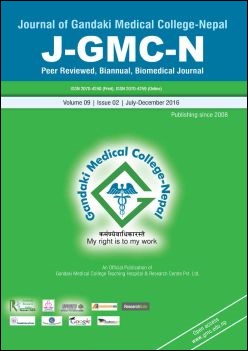An Overview of Sexual Assault Cases in Nepal
DOI:
https://doi.org/10.3126/jgmcn.v9i2.17865Keywords:
Anogenital injury, Rape, Sexual abuseAbstract
Background: Sexual assault is defined as any sexual act performed by one (or more) person(s) on another without consent. It may include the use of threat or force. In some cases, the person cannot give consent to sex because he/she is unconscious or otherwise incapacitated. A person may be raped by a stranger, an acquaintance or date or a family member.
Methods: The study was a retrospective and descriptive analysis of cases of sexual assault victims examined by the author in the Forensic Medicine departments at Institute of Medicine, Maharajgunj and Gandaki Medical College Teaching Hospital, Pokhara, Nepal over a period of four years (2012 to 2016). This includes information regarding the age group of the victim at the time of sexual abuse, relationship of the victim to the perpetrator, genital and extra-genital injuries present over the victim’s body and number of cases attended as an expert witness by the author in various courts of Nepal.
Results: In the four years period, a total number of 55 cases were examined as sexual assault cases. It was observed that majority were of the 13 - 15 years of age group (46%) followed by <10 years (20%), 16 - 20 years (16%), >20 years (11%) and 10 - 12 years (7%). Regarding the relationship of the victim to the alleged perpetrator, 87% cases (48 out of 55) were related to acquaintances compared to 13% due to strangers. Surprisingly, 3.6% cases (2 out of 48) were due to the biological fathers of the victims. On physical examination of the victim’s body, 36% cases showed genital injuries compared to only 15% with extra genital injuries. The author attended the court as an expert witness in 33% of these cases. Only 7% of the cases were mentally challenged.
Conclusion: Young adults remain the most vulnerable group, so education related to sex, morality, humanity and different life skills training should be provided to these groups from their school years itself. The benefits of early intervention and comprehensive care of survivors with the use of standardized protocols along with shorter and lesser traumatic period of court processing to the survivors of these cases should be encouraged.
Journal of Gandaki Medical College
Volume, 09, Number 2, July December 2016, Page: 43-46
Downloads
Downloads
Published
How to Cite
Issue
Section
License
This license allows reusers to distribute, remix, adapt, and build upon the material in any medium or format for noncommercial purposes only, and only so long as attribution is given to the creator.




